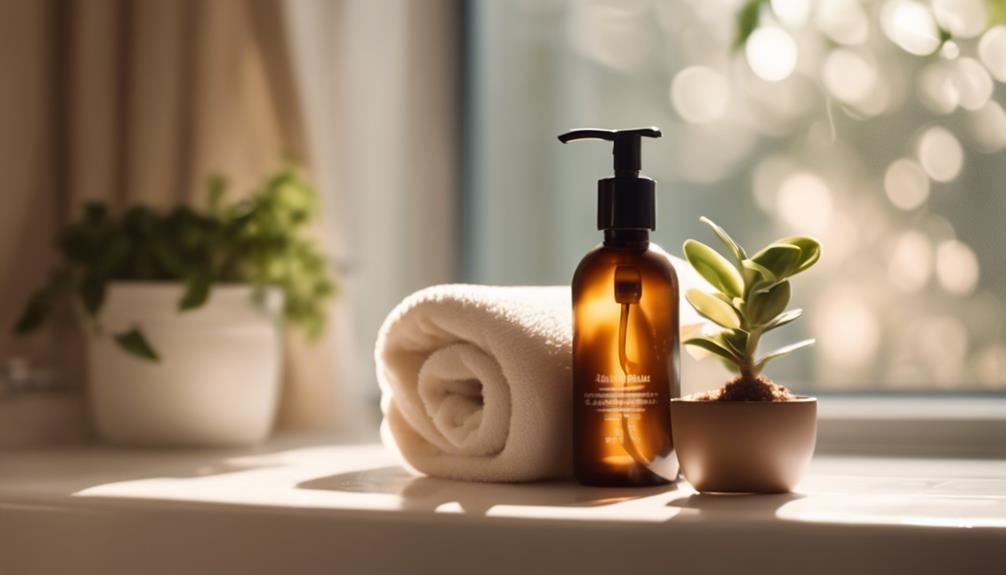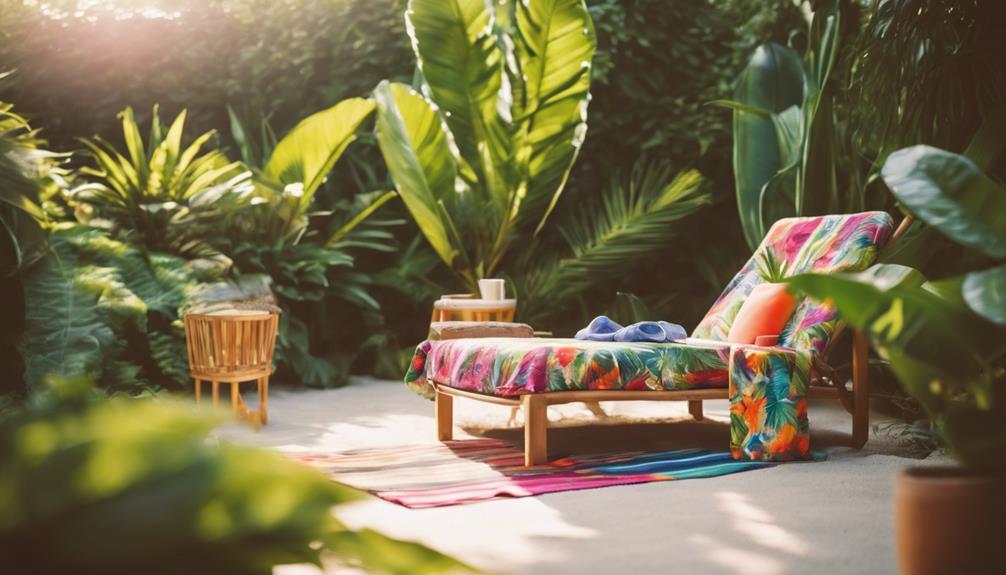You don't need to roast under the sun for that perfect tan! Safe tanning alternatives like self-tanning lotions and spray tans give you a gorgeous glow without UV risks. You can choose gradual tanning moisturizers to build your shade over time, or wash-off bronzers for a quick color fix. If you're feeling extra fancy, try professional spray tanning for a streak-free finish! Plus, these options are usually packed with hydrating ingredients, so your skin stays soft. So, if you want to shine bright without the burn, keep an eye out for more tips on how to look radiant!
Key Takeaways
- Self-tanning lotions with DHA provide a sun-kissed look without UV exposure risks, promoting skin health.
- Gradual tanning moisturizers hydrate skin while building a natural tan over time.
- Spray tans offer quick, professional application for a flawless, even bronzed finish.
- Natural bronzers and tinted lotions enhance skin tone while offering protection from harmful rays.
Safe Self-Tanning Options
When it comes to achieving a beautiful glow without the risks of UV exposure, safe self-tanning options like lotions and sprays let you effortlessly bronzer up at home.
Imagine slathering on a luscious lotion that transforms you into a golden goddess without a single sunburn! Self-tanning lotions contain dihydroxyacetone (DHA), which reacts with your skin to give you that sun-kissed look.
If you're in a hurry, spray tans offer a quick and easy way to get an even tan, while gradual tanning moisturizers build your color day by day, keeping your skin hydrated.
For those wanting a little fun without commitment, wash-off bronzers provide temporary color that washes away, letting you shine for the day and go back to your natural self tomorrow!
Professional Tanning Services

If you're looking for a more tailored approach to your tan, professional tanning services offer customizable options that guarantee a flawless finish.
With experienced technicians and state-of-the-art equipment, you can achieve that sun-kissed glow without the sunburn.
Here are some benefits you can expect:
- Quick Transformation: Spray tanning booths can give you a beautiful tan in just minutes!
- Custom Shades: You can choose your perfect shade, from sun-drenched gold to deep bronze.
- Streak-Free Application: Trained professionals ascertain an even tan that looks natural.
- Healthier Choice: These services avoid harmful UV rays, keeping your skin safe.
Natural Tanning Alternatives

Natural tanning alternatives offer a guilt-free way to achieve a sun-kissed glow without the risks associated with UV exposure.
You can use natural bronzers and powders that give you that radiant look in just a few swipes. Tinted lotions not only add color but also protect your skin, making you feel like a superstar while keeping your natural tone intact.
If you prefer something less permanent, gradual tanning moisturizers help you build your desired shade over time. And let's not forget wash-off bronzers—they're perfect for those days when you want to shine but don't want to commit!
With these options, you can enjoy a beautiful glow without any of the worries. Who wouldn't want that?
Health Benefits of Sunless Tanning

Sunless tanning consistently offers a safe way to achieve a radiant glow without the harmful effects of UV exposure. You can enjoy a fabulous tan while keeping your skin healthy!
Here are some amazing health benefits of sunless tanning:
- No UV Damage: You skip the sun's harmful rays, reducing your risk of skin cancer.
- Even Tone: Sunless tanners provide a smooth, streak-free color that looks natural.
- Hydration Boost: Many self-tanners are infused with moisturizing ingredients, keeping your skin soft.
- Instant Confidence: A bronzed glow can instantly lift your mood and boost your self-esteem!
Practical Tanning Tips

Achieving a beautiful tan is all about technique, and following these practical tips can help you maximize your results while keeping your skin healthy.
First, always exfoliate before applying any self-tanner; it helps remove dead skin cells, giving you a smooth canvas.
Next, use a moisturizer on dry areas like elbows and knees to avoid dark patches.
When applying your self-tanner, use circular motions to guarantee even coverage, and don't forget those tricky spots like your back!
If you're using a spray tan, hold the nozzle about six inches away for the best results.
Finally, let your tan develop fully before showering, and remember: practice makes perfect.
Your sun-kissed glow is just a few steps away!
Trending Tanning Topics

Trending topics in the tanning world often focus on innovative practices that prioritize skin health and safety. You'll find it exciting to know that people are moving away from traditional tanning methods!
Here are some fun trends making waves:
- Proper Tanning Bed Cleaning Tips – Hygiene matters, and knowing how to clean your tanning bed keeps everyone safe and healthy.
- Best Tanning Bed Goggles – Protecting your eyes is key, so check out the top picks for 2025!
- Pre-Tanning Bed Skin Prep – Get the most out of your tan by prepping your skin the right way.
- Sunless Tanning Innovations – Discover new products that give you that sun-kissed glow without the harmful rays!
These trends guarantee you can achieve that radiant look while keeping your skin safe and sound!
Maintaining Radiant Skin

To keep your skin looking radiant after opting for safe tanning methods, it's important to establish a consistent skincare routine that nourishes and protects your complexion.
Start by cleansing your skin daily to remove impurities and keep those pores happy. Then, don't forget to moisturize! A good moisturizer will keep your skin hydrated and help maintain that glorious glow.
Exfoliating once or twice a week can also be your secret weapon; it sloughs off dead skin cells, ensuring your tan looks even and fresh.
And remember, sunscreen is a must—even if you're not tanning! It protects your skin from harmful rays, keeping it healthy.
Frequently Asked Questions
How Long Do Self-Tanners Typically Last on the Skin?
Self-tanners usually last about five to seven days on your skin. To maintain your glow, keep your skin moisturized and avoid exfoliating too much. Reapply as needed for a consistent, sun-kissed look.
Can I Shower After Applying Self-Tanner?
You can shower after applying self-tanner, but wait at least four to eight hours for ideal results. This allows the product to develop fully, ensuring a richer, longer-lasting tan without streaks or unevenness.
Are There Any Side Effects From Using Self-Tanners?
Yes, there can be side effects from using self-tanners. You might experience skin irritation, allergic reactions, or uneven color. Always patch-test new products and follow instructions to minimize potential issues while achieving your desired tan.
How Can I Remove Self-Tanner if I Dislike the Color?
If you dislike the color of your self-tanner, think of it like a stubborn ink stain. Use an exfoliating scrub, baking soda paste, or a gentle acid-based remover to help lift the unwanted tint effectively.
Do Self-Tanners Provide Any Sun Protection?
Self-tanners don't offer sun protection; they only create a bronzed look without UV exposure. To protect your skin, always apply a broad-spectrum sunscreen alongside your self-tanner for thorough safety while enjoying your glow.
What Safe Tanning Alternatives Can I Use for Healthier Sunless Tanning?
Looking for healthier sunless tanning solutions? Consider using self-tanning lotions, sprays, or mousses that contain natural ingredients like aloe vera or coconut oil. You can also try bronzing powders or tinted moisturizers for a safer glow. Remember to always wear sunscreen, even with these alternatives.
Conclusion
So, there you have it! With safe tanning options, you can glow without frying your skin.
Imagine your friend Jenna, who used a gradual tanning lotion for her summer dance recital—she looked fabulous and felt confident without a sunburn in sight!
By choosing self-tanners, professional services, or natural alternatives, you're prioritizing your health while rocking that radiant look.
Remember, it's all about finding what works for you, so go ahead and shine on with confidence!









